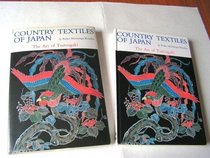Tsutsugaki is a method of dyeing cloth using a resist agent to create a particular design. Though it has much in common with the more familiar Japanese batik and stencil-dying techniques, tsutsugaki is unique in the way the dye resist--in this case rice paste--is applied to the fabric. By squeezing the rice paste through a paper cone the textile artist draws, freehand, his chosen design. The results are a delightful sponteneity and rare individuality of expression that have come to distinguish tsutsugaki textiles. This technique boasts a long history in both cities and the countryside. This volume brings to light the little-known country tsutsugaki tradition, distinctive for its ceremonial textiles. These celebretory country textiles are stunningly reproduced in 48 plates, 16 in full color. The commentaries on the plates detail the history, particular function, design, materials, and method of execution for each piece. Forty-three black and white photographs and line drawings illustrate the text, in which the author traces the history of cotton and indigo cultivation in Japan in relation to the development of tsutsugaki, and offers a fascinating account of the creation of indigo dye--from the initial planting and harvesting of the indigo plants to the final preparation of the fermented dye bath. In addition, readers are invited inside one of the last remaining tsutsugaki dye shops where, closely observing the Nagata family at work, we are given the rare chance to witness the step-by-step making of traditional tsutsugaki textiles. This is the first such study in English of a truly representative Japanese textile tradition.
Search -
Country Textiles of Japan: The Art of Tsutsugaki
Country Textiles of Japan The Art of Tsutsugaki
Author:
History, methodology and motifs of this important resist technique popular throughout Japan, Kimonos, headpieces, ceremonial banners; their function, techniques, fabrics. Distributed by Woodstocker Books.
Author:
History, methodology and motifs of this important resist technique popular throughout Japan, Kimonos, headpieces, ceremonial banners; their function, techniques, fabrics. Distributed by Woodstocker Books.
ISBN-13: 9780834802070
ISBN-10: 0834802074
Pages: 160
Edition: 1st
Rating: 1
ISBN-10: 0834802074
Pages: 160
Edition: 1st
Rating: 1
4 stars, based on 1 rating
Publisher: Weatherhill
Book Type: Hardcover
Other Versions: Paperback
Members Wishing: 1
Reviews: Member | Amazon | Write a Review
Book Type: Hardcover
Other Versions: Paperback
Members Wishing: 1
Reviews: Member | Amazon | Write a Review
Please Log in to Rate these Book Reviews
Genres:
- Arts & Photography >> History & Criticism >> General
- Arts & Photography >> Art >> Instruction & Reference >> General
- Arts & Photography >> Art >> General
- History >> Asia >> Japan
- Crafts, Hobbies & Home >> Crafts & Hobbies >> Dye
- Crafts, Hobbies & Home >> Crafts & Hobbies >> Needlecrafts & Textile Crafts >> Texting Arts




